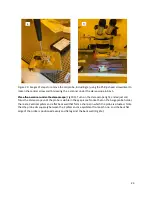
18
Saving data as an image, and image processing
Data is saved in an .ibw (Igor binary wave) file extension. This data formate is not an image or surface
measurement file. The user will use some software, either the Asylum program on the tool or image
processing software such as Gwiddeon, to manipulate the .ibw file to obtain useful data. Here, the user
will find some useful information on
how to export data as a 2D image in a JPEG or TIFF format, how to
generate a 3D rendering of data, and how to obtain surface roughness measurements from an image.
Close all other windows, or drag them out of the way. The user will be opening other windows to locate
data and perform image processing.
Open the Data from the Widows file explorer. Locate the desired .ibw file. Left click on the file name
and drag it from the File Explorer into the Asylum software.
A widow with the user’s collected image appears. The user can toggle between the height data,
amplitude data, phase data, and the Z sensor data by toggling between the “HtR,” “AmR,” “PhR,” and
“ZSr”
, respectively, tabs in this window.
The user may be curious about the difference between height and z sensor data. The shortest
explanation is that for data in the micron range down to 100 nm, the z sensor data tends to be the best
image with less noise. For images with height data that is less than 100 nm, the height channel is the
best. The other data channels are not useless. Users may also find that they can generate impressive
images with phase data, provided they can tune the scan parameters to optimize phase contrast. At this
point, that is an exercise left up to the user.
At any rate, the data that appears in the window is not truly raw data. The software automatically saves
the data with a 1
st
order flattening algorithm; the algorithm corrects for distortions in the image that
arise from the nature of the tapping mode raster. To view the raw data, click on the M button in the
data window.
This opens a Modify panel that is open to a “Flatten” tab
(Fig 16a)
. Click the “ultra
-
restore” option to restore the data to its raw form
. There are additional forms of data filtering and
correction that are available, but not yet discussed here.





















